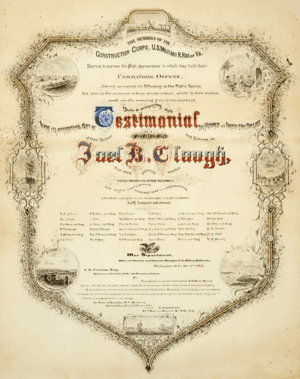List of US military railroad civil engineers in the American Civil War facts for kids
The U.S. Military Railroad (USMRR) was a special group created by the U.S. War Department. Its job was to take over and run railroad lines that the government captured during the American Civil War. In January 1862, President Abraham Lincoln was given permission to use railroads and telegraphs for military needs. However, the USMRR mostly focused on the rail lines they captured in the Southern states. This organization was a very early version of what we now know as the United States Army Transportation Corps.
Building and Repairing Railroads During the Civil War
During the Civil War (1862-1867), railroads were super important. They helped move soldiers, supplies, and weapons quickly. But war often damaged these rail lines. That's where the USMRR and its amazing civil engineers came in! These engineers were like problem-solvers. They built new tracks, repaired damaged ones, and kept the trains running. Their hard work was key to how the war was fought.
Engineers in Virginia (1862–1866)
Many skilled engineers worked on military railroads in Virginia. This state was a major battleground, so keeping the rail lines working was vital. These engineers helped repair tracks and manage train movements, especially around important cities like Alexandria and City Point.
- Anderson, Adna (1827–1889): He was an engineer who helped repair railroads coming from Alexandria.
- Beggs, John S. (1821–1889): He managed railroads near Harper's Ferry, West Virginia.
- Clough, Joel Barber (1823–1887): He was a construction engineer.
- Devereux, John Henry (1832–1886): He was a superintendent for railroads near Alexandria.
- Hays, T. D.: He helped repair railroads from City Point.
- Henry, William E. (1820–1900): He was a supervisor for construction in Alexandria.
- Huntington, G. M.: He managed railroads from City Point.
- McAlpine, C. L.: He helped repair railroads from City Point.
- Moore, James J. (1821–1899): He was an engineer who repaired railroads from Alexandria.
- Wentz, Erasmus Livingston (1818–1900): He was an engineer and superintendent for railroads near Richmond and Norfolk.
- Wright, William Wierman (1824–1882): He was an engineer and superintendent for the Aquia Creek Railroad.
Engineers in the Mississippi Department (1864–1865)
The USMRR also had a big job in the western parts of the war, especially around the Mississippi River. This area included states like Tennessee and Kentucky. Engineers here helped build and repair lines that supported major military campaigns.
- Anderson, Adna (1827–1889): He became the general superintendent for all railroads in this area in 1864.
- Clark, Col. John (1822–1872): He was in charge of building the Nashville and Northwestern railroad.
- William McDonald: An assistant engineer working with Colonel Clark.
- Charles Latimer: Another assistant engineer.
- Eicholtz, L. H. (1827–1911): He was a division engineer and sometimes acted as the chief engineer.
- Goodhue, A. F. (d.1912): He was an engineer and superintendent for railroads in Memphis, Tennessee, and Columbus, Kentucky.
- Hebard, Alfred (1811–1896): He was an engineer who repaired railroads around Nashville.
- Smeed, Eben C.: He was a division engineer and later helped with repairs in North Carolina.
- Stevens, W. J.: He managed railroads from Nashville and later became a general superintendent.
- Wentz, Erasmus Livingston (1818–1900): He became a general superintendent for railroads in 1865.
- Wright, William Wierman (1824–1882): He was the chief engineer of the Construction Corps and later a general superintendent in North Carolina.
These engineers and their teams played a huge role in the Civil War. They showed how important railroads were for military success and helped shape the future of transportation in the United States.


